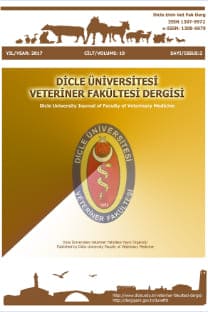Parvoviral Enteritise Bağlı Septik veya Septik Olmayan Köpeklerde Hematolojik Durum
Hemogram, köpek, parvoviral enterit, sepsis
Hematological Status in Septic or Non Septic Dogs due to Parvoviral Enteritis
Dog, hemogram, parvoviral enteritis, sepsis,
___
- Gülersoy E, Ok M, Yıldız R, Koral E, İder M, Sevinç M, Zhunushova A. (2020). Assessment of Intestinal and Cardiac-related Biomarkers in Dogs with Parvoviral Enteritis. Pol J Vet Sci. 23(2): 211-219.
- Alves F, Prata S, Nunes T, Gomes J, Aguiar S, Aires da Silva F, Tavares L, Almeida V, Gil S. (2020). Canine Parvovirus: A Predicting Canine Model for Sepsis. BMC Vet Res. 16(1): 199.
- Mylonakis ME, Kalli I, Rallis TS. (2016). Canine Parvoviral Enteritis: An Update on the Clinical Diagnosis, Treatment, and Prevention. Vet Med (Auckl).7: 91-100.
- Krentz T, Allen S. (2017). Bacterial Translocation in Critical Illness. J Small Anim Pract. 58(4): 191-198.
- Drobatz KJ, Hopper K, Rozanski EA, Silverstein DC. (2019). Gastroenteritis. In: Textbook of Small Animal Emergency Medicine. Drobatz KJ, Hopper K, Rozanski EA, Silverstein DC (eds). 1st ed. pp. 485-486. Wiley-Blackwell, New Jersey, USA.
- Yilmaz Z, Senturk S. (2007). Characterisation of Lipid Profiles in Dogs with Parvoviral Enteritis. J Small Anim Pract. 48(11): 643–50.
- Goddard A, Leisewitz A. (2010). Canine Parvovirus. Vet Clin NA Small Anim Pract. 40(6):1041–1053.
- Singer M, Deutschman CS, Seymour C, Shankar-Hari M, Annane D, Bauer M. (2016). The Third International Consensus Definitions for Sepsis and Septic Shock (sepsis-3). JAMA. 315: 801–810.
- Bone RC, Balk RA, Cerra FB, Dellinger RP, Fein AM, Knaus WA (1992). Definitions for Sepsis and Organ Failure and Guidelines for the Use of Innovative Therapies in Sepsis. Chest. 101(6): 1644–1655.
- Sykes JE. (2014). Canine Parvovirus Infections and Other Viral Enteritides. Canine and Feline Infectious Diseases. PMC7152455: 141-151.
- Levy MM, Fink MP, Marshall JC, Abraham E, Angus D, Cook D. (2003). 2001 SCCM/ESICM/ACCP/ATS/SIS International Sepsis Definitions Conference. Intensive Care Med. 29(4): 530–538.
- Goddard A, Leisewitz AL, Christopher MM, Duncan NM, Becker PJ. (2008). Prognostic Usefulness of Blood Leukocyte Changes in Canine Parvoviral Enteritis. J Vet Intern Med. 22(2): 309-316.
- Sharp CL. (2018). Systemic Inflammatory Response Syndrome, Sepsis, and Multiple Organ Dysfunction Syndrome. In: Textbook Of Small Animal Emergency Medicine. Drobatz KJ, Hopper K, Rozanski E, Silverstein DC (eds). pp. 1030-1037. Wiley Blackwell, New Jersey, USA.
- Girardot T, Rimmelé T, Venet F, Monneret G. (2016). Apoptosis-induced Lymphopenia in Sepsis and Other Severe Injuries. Apoptosis. 22(2): 295-305.
- Prittie J. (2004). Canine Parvoviral Enteritis: A Review of Diagnosis, Management, and Prevention. Vet Emerg Crit Care. 14(3): 167-176.
- Gülersoy E, Balıkçı C, Günal İ, Şahan A. (2022). Evaluation of the Efficacy of Blood Gases and Hemogram Parameters in the Diagnosis of non Neurogenic Distemper and Parvoviral Enteritis in Dogs with Acute Gastroenteritis. Revista Cientifica, FCV-LUZ. 32(rcfcv-e32091): 1-8.
- Loughlin PC, Sebat F, Kellett JG. (2018). Respiratory Rate: The Forgotten Vital Sign—Make It Count! Jt Comm J Qual Patient Saf. 44(8): 494-499.
- Sharma R, Kumar A, Goel P, Kumar R. (2008). Clinical Haematology in Canine Haemorrhagic Gastroenteritis. Haryana Vet. 47(8): 35-38.
- Wysoke JM, Van Heerden J. (1990). Polycythemia Vera in a Dog. J S Afr Vet Assoc. 61(4):182–183.
- Biswas S, Chakravorty D, Pradhan NR. (2005). Clinical and Haemato-biochemical Changes in Parvovirus Infection in Dogs. Indian J Vet Med. 25(1): 16-18.
- Alves FS, Barbosa BC, Coelho NGD, Pinto PCO, Campos MTG, Horta RS, Freitas PMC, Beier SL, Paes PRO. (2019). Clinical and Hematological Prognostic Factors in Dogs with Parvoviral Enteritis and Sepsis. Braz J Dev. 40(3): 1477-1488.
- Gülersoy E, Kapar MM, Durgut MK, Naseri A, Ok M. (2022). Evaluation of Clinical, Hematochemical and Cerebrospinal Fluid Analysis Findings in Dogs Naturally Affected by the Neurological Form of Canine Distemper. Magy Allatorvosok Lapja. 144(1): 13-29.
- Pierini A, Gori E, Lippi I, Lubas G, Marchetti V. (2020). Are Leukocyte and Platelet Abnormalities and Complete Blood Count Ratios Potential Prognostic Markers in Canine Sepsis? Front Vet Sci. 7:578846.
- Lee SH, Kim JW, Lee BC, Oh HJ. (2020). Age-specific Variations in Hematological and Biochemical Parameters in Middle- and Large-sized of Dogs. J Vet Sci. 21(1): e7.
- ISSN: 1307-9972
- Yayın Aralığı: Yılda 2 Sayı
- Başlangıç: 2008
- Yayıncı: Dicle Üniversitesi Veteriner Fakültesi
Propolis ve Ruminantlarda Alternatif Yem Katkı Maddesi Olarak Kullanımı
Farklı Kedi Irklarının Testislerinde Sitokeratin 8’in İmmunohistokimyasal Lokalizasyonu
Zelal KARAKOÇ, Uğur TOPALOĞLU, Mehmet Erdem AKBALIK, Berna GÜNEY SARUHAN, Nurşin AYDIN
Antimikrobiyel Direnç: Küresel Bir Sorun
Parvoviral Enteritise Bağlı Septik veya Septik Olmayan Köpeklerde Hematolojik Durum
A. Ezgi TELLİ, Nihat TELLİ, Yusuf DOĞRUER, Yusuf BİÇER
Gülşah SARAL, Firdevs BİNLİ, Serhan Serhat AY
Gebeliğin Sonunda Uygulanan Enerji Eksikliğinin Koyun ve Kuzu Doğum Ağırlıkları Üzerine Etkisi
Mehmet Hanifi DURAK, Atila ATEŞ, Tanay BİLAL
Halit Deniz ŞİRELİ, Mehmet ÇOLAK
Kırıkkale İlinde Kesilen Simental Irkı Sığırların Bazı Kesim ve Karkas Özellikleri
